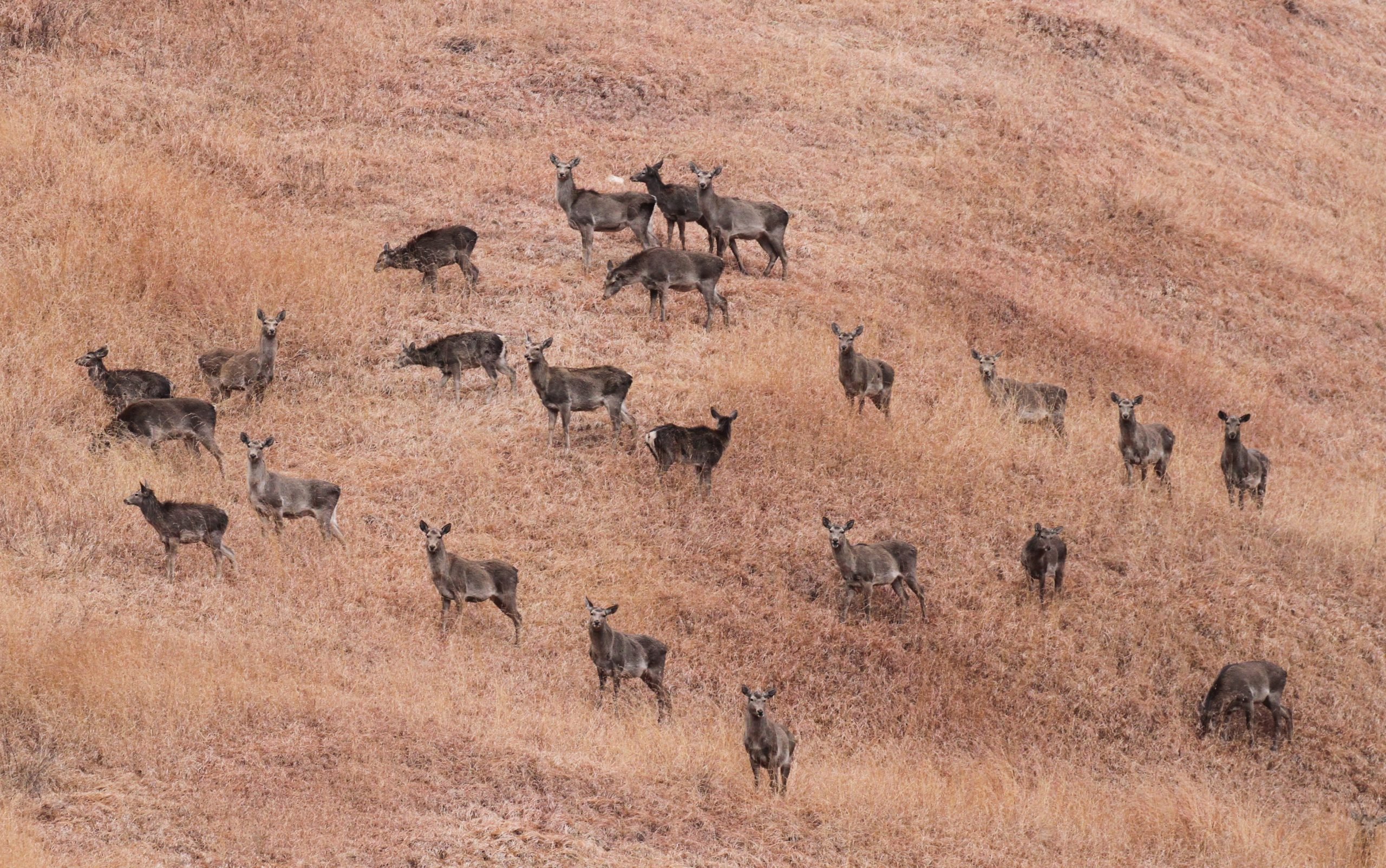Before August 5, 2019, when the former state of Jammu & Kashmir was converted into the union territories of Ladakh and Jammu & Kashmir, the Hangul (Cervus Hanglu), was the state animal of Jammu & Kashmir and the black-necked crane, its state bird.
Being the state animal, the Hangul has been at the centre of wildlife conservation efforts in Kashmir for decades. However, after the change in political status of Jammu and Kashmir, no notification has so far been issued about the Hangul being declared as the Union Territory (UT) animal for Jammu and Kashmir.
Meanwhile, an order has been issued by the Jammu & Kashmir government to the wildlife protection department to identify the new UT bird for Jammu & Kashmir. The erstwhile state bird of Jammu and Kashmir, the black-necked crane, is found only in Ladakh which has been carved out as a separate union territory.

Their appealing physical features and large size made the black-necked crane and the Hangul perfect representations of the region’s rich wildlife. Black-necked cranes are giant birds with whitish bodies, long slender black legs and long black necks with a red crown adorning their heads. They live on high altitudes in the Tibetan plateau, Ladakh and Bhutan, and are the only species of the crane family in such habitats. It is the undisputed king of birds in the Ladakh and Kashmir Himalayas and was, therefore, a natural choice for the state bird.
Now, the wildlife department of Jammu and Kashmir is in the process of identifying the new UT bird, confirmed Rashid Naqash, Kashmir’s regional director for Wildlife Department. He added that his department is soon expecting a notification on the Hangul being declared as the UT animal.
Kashmir flycatcher
Asad Rahmani, former director of the Bombay Natural History Society (BNHS), who has worked extensively in Kashmir, told thethirdpole.net that the Kashmir flycatcher (Ficedula subrubra) “is the best choice” for the new state bird.
“I strongly feel that the Kashmir flycatcher should now become the state bird [of Jammu and Kashmir] as it is named after the state and it is a rare forest bird,” Rahmani said, adding that International Union for Conservation of Nature (IUCN) has listed it as vulnerable. The Kashmir flycatcher is a small bird (13 cm), the same size of its cousin, the red-throated flycatcher (Ficedula parva). He said that it is found on both sides of the Line of Control (which divides parts of Kashmir administered by India and Pakistan) in Pir Panjal, Neelum Valley and Qazi Nag as well as in Sri Lanka, Nepal and Bhutan.
“The Kashmir flycatcher only breeds in Kashmir (in the forests) and has a small distribution elsewhere,” Rahmani said.

Significance of the state animal
Referring to the significance of identifying a bird or animal with the state or country, he said, “It certainly helps in protecting the species as people start taking pride in the bird or animal and love it. We have seen how Gujaratis feel proud about the Asiatic lion and flamingo, Kashmiris feel proud about the Hangul and Indians feel pride for the tiger.”
M K Ranjitsinh, India’s renowned wildlife conservationist and architect of the Wildlife (Protection) Act 1972 said that it is of “huge significance” when animals, birds and trees are identified with a certain region.
“That is why we have always recommended it for all states and union territories,” said the seasoned wildlife expert who has also recently written a book on wildlife titled A Life with Wildlife. Almost all the UTs, he said, have state animals and birds “which is a good thing for conservation.” He suggested that Jammu & Kashmir should now have a residential bird as its state bird.
About the Hangul, he said that there is an urgent need to protect the animal from extinction. Ranjitsinh added that the Dachigam ecosystem is the Hangul’s only hope now. “Outside of it (Dachigam), the scattered few would, perhaps, number less than ten. Upper Dachigam, which was their traditional summer breeding ground, is now occupied by the Gujar shepherds and their dogs in the summer,” he writes in his book.
Declining Hangul population
Also known as the Kashmir stag, the IUCN Hangul has historically been as significant to the state of Jammu & Kashmir as the tiger is to India. There has been a massive decline in the Hangul population to the extent that it is now the most critically endangered species. It is the only Asiatic survivor or sub-species of the European red deer.
The IUCN’s Red Data Book – which contains lists of species at risk of extinction – has declared the Hangul as one of three species that were critically endangered in Jammu & Kashmir. The other two are the Markhor – the world’s largest species of wild goat found in Kashmir and several regions of central Asia – and the Tibetan antelope or ‘chiru’ found mostly in the mountainous regions of Mongolia and the Himalayas.
Placed under Schedule I of the Indian Wildlife (Protection) Act, 1972 and (now repealed) Jammu and Kashmir Wildlife Protection Act, 1978, the Hangul was once widely distributed in the mountains of Kashmir and parts of the Chamba district of neighbouring Himachal Pradesh.
Today, this iconic animal is restricted to the Dachigam National Park in the neighbourhood of Jammu and Kashmir’s summer capital Srinagar, covering an area of 141 square kilometres.
From a population of 5,000 in the early 1900s, the Hangul’s numbers have constantly declined over the decades, making it largely confined to the 141 square kilometres of the Dachigam National Park. Some studies suggest that small isolated Hangul herds of five to ten have been reported from adjoining areas of Dachigam which include Shikargah-Tral and the Overa-Aru Wildlife Sanctuary in south Kashmir.
According to the latest population monitoring survey of the Hangul conducted by the Wildlife Department in 2019, the number of Hangul in Dachigam and adjoining areas is 237. Earlier population estimates suggest that there were 197 in 2004 and almost a similar number (186) in 2015 and 182 in 2017.
“The population has been steady for the last 10 to 12 years. But the area has a far greater carrying capacity despite the fragmentation of forested habitats of Hangul,” said Intisar Suhail, a wildlife expert and one of the wildlife wardens in Kashmir.
Conservation challenges
A prime conservation measure taken by the wildlife department of Jammu & Kashmir in recent years was the establishment of a Hangul breeding centre along with some infrastructure over a five-acre forested area in south Kashmir’s Shikargah-Tral, a few years back. But the breeding programme never took off. Naqash attributes it to the fact that his department “could not get the right parental stock.”
What his department is also struggling with is the influx of nomadic herds in the Dachigam National Park. After the closing down of traditional routes leading to over a dozen alpine pastures after the inception of armed conflict in Kashmir by the army, nomads have not been able to graze their herds in those pastures. As a result they take their large herds of livestock to the upper reaches of Dachigam during the summer, officials at the department argue.
Population ratio
Another challenge is the male-female and fawn-adult disparity in the Hangul population. According to the 2019 population monitoring survey, there has been “quite an alarming” decline in fawn-female and male-female ratio of Hangul. The fawn-female ratio has witnessed a massive decline and wildlife experts say that the reasons need to be looked into promptly if the conservation of the Hangul has to be made possible.
According to the data of the monitoring survey, there were 7.5 fawns per 100 females and 15.5 males per 100 females. This ratio is far lower than the 19.1 and 15.8 (respectively) found during 2017 population monitoring survey.
Khurshid Ahmad of Sher-e-Kashmir University of Agricultural Science and Technology (SKUAST), who has extensively carried out research on Hangul, said that the decline in the Hangul’s population is mainly occurring due to the low recruitment rate of fawns to adults.
“There is a female-biased ratio of males to females. The female-biased ratio and the poor fawn to female ratio are the two main reasons for the declining numbers of Kashmir’s Hangul,” Ahmad said.
Intisar Suhail pointed out the same problem, “If we analyse the Hangul population in recent years (especially after the year 2000), there has not been any significant improvement in numbers nor a drastic decline. But what needs to be studied carefully and scientifically is the massive decline in the fawn-female ratio and male-female ratio.”
Predation
Other reasons, as per Ahmad’s research paper, include excessive predation of fawns by the common leopard, black bear and nomads’ dogs as well as continued Hangul summer habitat loss and degradation due to excessive livestock grazing in the upper Dachigam.
Lack of stability in the Hangul population is a nagging concern for conservationists.
Rahmani said that the conservation project of the Hangul should be started urgently before the animal is wiped out. “The conservation breeding of the Hangul should start today; not tomorrow. The government of Jammu and Kashmir should not wait anymore,” Rahmani said.
He said that the ultimate aim of the conservation breeding programme, which is carried out with all the necessary protocols, is to release the animals into the wild. “Conservation breeding suits the Hangul as it is a deer,” he said. He added that a foundation stock of at least 15 Hangul should be there to ensure a successful conservation breeding.
Rahmani added that the conservation breeding project should be allotted to some expert agency by the Jammu & Kashmir government without any delay. Naqash agreed and said that the government is very serious about starting the conservation programme very soon.








![Phuentsholing Gas Station in Bhutan. Petrol stations create problems of emissions in a country too dependent on cars [image by: Omair Ahmad]](https://dialogue.earth/content/uploads/2020/01/Phuentsholing-Gas-Station-300x225.jpg)
